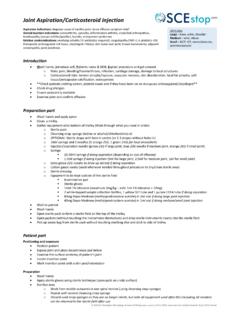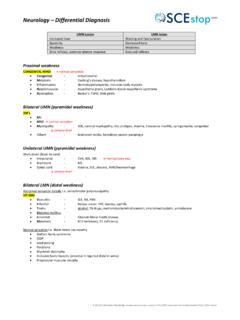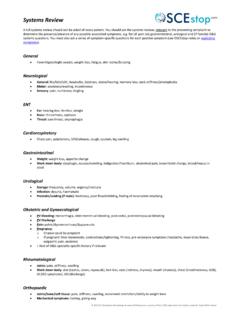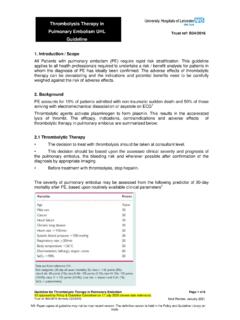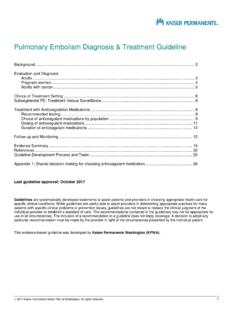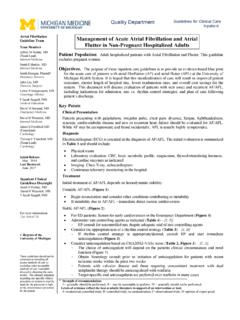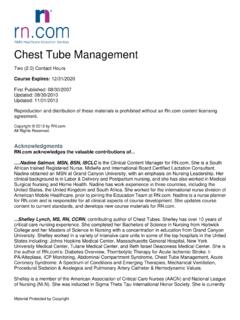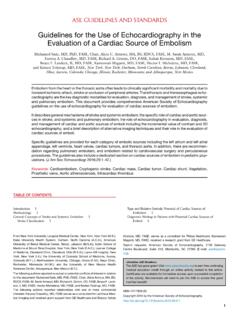Transcription of Differential Diagnosis of Acute Shortness of Breath
1 2015 Dr Christopher Mansbridge at , a source of free OSCE exam notes for medical students finals OSCE revision Differential Diagnosis of Acute Shortness of Breath Cause grouping Differentials Classical history Classic examination findings Investigation findings (Initial test, diagnostic test) Definitive management (remember ABCDE first) Respiratory Pulmonary embolism Pleuritic chest pain Haemoptysis & SOB Risk factors (long haul flight, recent surgery, immobility) CVS: tachycardia, JVP distension, RV heave, loud P2, right S4 RS: tachypnoea, clear chest CALVES: look for DVT SBP<90/pulselessness/persistent bradycardia = massive PE D-Dimer (if low Wells score): raised CT pulmonary angiogram ECG: tachycardia, RV strain (T wave inversion in right chest and inferior leads), RBBB, right axis deviation, S1Q3T3 pattern rare ABG: hypoxia, hypocapnia CXR: may be wedge opacity, regional oligaemia, enlarged pulmonary artery, effusion Treatment dose LMWH Thrombolysis if massive PEPneumonia Fever Shortness of Breath Productive cough Pleuritic chest pain Confusion Tachypnoea, cyanosis Coarse crepitations and bronchial breathing Dullness to percussion Increased vocal resonance/tactile vocal fremitus CXR: consolidation, air bronchogram Inflammatory markers: raised Identify cause Sputum culture Urinary pneumococcal and legionella antigens Blood culture Antibiotics Pneumothorax Sudden onset pleuritic chest pain May be SOB if large Risk factors Marfan s appearance, COPD/asthma Ipsilateral Reduced chest expansion Absent Breath sounds Hyperresonance Tension pneumothorax JVP distension, hypotension Tracheal deviation (away from affected side) CXR.
2 Air in pleural spacePrimary <2cm CXR monitoring >2cm or Sx aspirate Secondary <1cm observe for 24h 1-2cm aspirate >2cm or Sx chest drain Asthma exacerbation Dyspnoea Wheeze Asthmatic Cyanosis, tachypnoea Use of accessory muscles Polyphonic wheeze Reduced air entry Reduced PEFRC linical Diagnosis CXR: exclude infection and pneumothorax ABG: usually normal PaO2 and low PaCO2 (hyperventilation), if PaO2 or PaCO2, patient is tiring Blood and sputum cultures if evidence of infection Salbutamol nebs Ipratropium nebs Steroids Magnesium IV Antibiotics if evidence ofinfection COPD exacerbation Dyspnoea Wheeze Change in sputum Known COPD or lifelong smoker Cyanosis, tachypnoea Use of accessory muscles Polyphonic wheeze Reduced air entryClinical Diagnosis CXR: exclude infection and pneumothorax ABG: hypoxia, hypercapnoea Salbutamol nebs Ipratropium nebs Steroids Antibiotics BiPAP if required Other respiratory differentials Extrinsic allergic alveolitis; laryngitis; bronchitis; pneumonitis; bronchiectasis.
3 LRTI Cardiac ACS Crushing central chest pain Radiates to neck/left arm Associated nausea/SOB/sweatiness Cardiovascular risk factors May be normal General: sweaty, SOB, in pain CVS: S4 gallop, JVP distension, signs of heart failure, brady/tachycardic ECG: ST elevation (or new LBBB), inverted T waves, Q waves Troponin: increased (butnormal in unstable angina) CXR: normal or signs of heart failure Coronary angiography MONAC Primary coronary intervention Acute LVF SOB, orthopnoea, PND Pink frothy sputum Peripheral oedema Cardiac history Tachycardia, tachypnoea Raised JVP Fine bi-basal crepitations S3 gallop rhythm Peripheral oedema CXR: Alveolar shadowing, B lines, Cardiomegaly, Diversion of blood to upper lobe, Effusion Echocardiogram BNP ECG: look for MI Furosemide GTN infusion CPAP if required Treat cause (if any)Other cardiac differentials Cardiomyopathy; myocarditis; Acute valvular disease; pulmonary hypertension Other Hyperventilation in anxiety Tight chest pain, SOB, sweating, dizziness, palpitations, feeling of impending doom Anxious personality & other symptoms of generalised anxiety disorder Recurrent episodes triggered by a stimulus ( crowds) Usually normal Hyperventilation Clinical Diagnosis ECG: exclude MI Troponin: exclude MI CXR: exclude infection ABG: respiratory alkalosis Reassurance CBTO ther differentials DKA; overdoses; metabolic acidosis; sepsis/SIRS; foreign body; anaphylaxis
